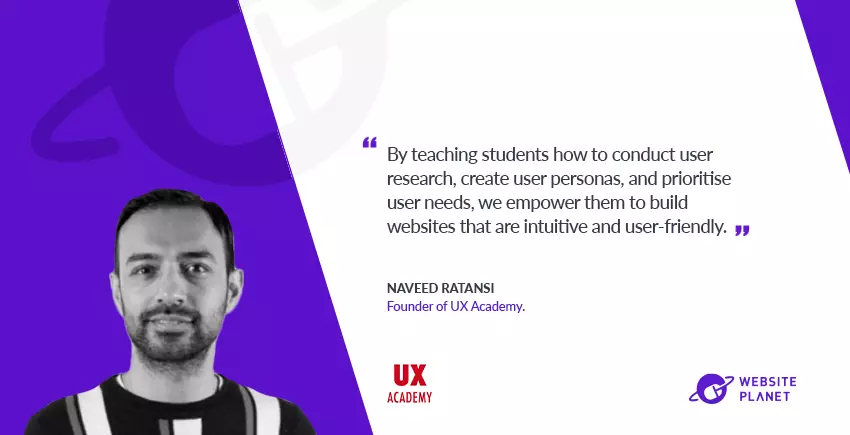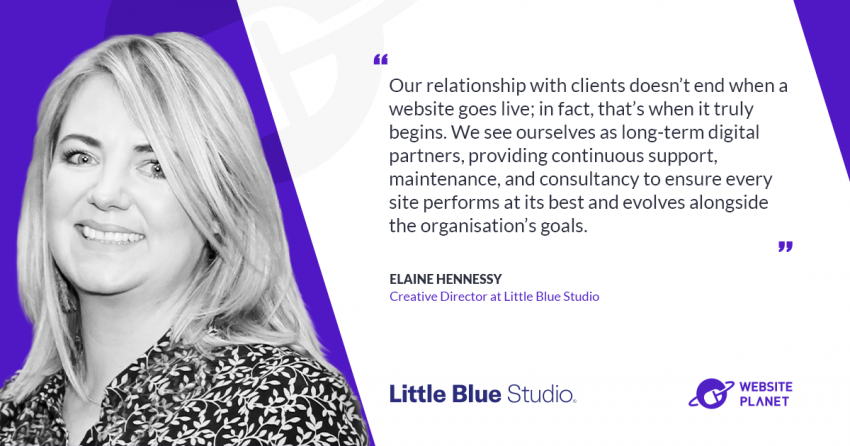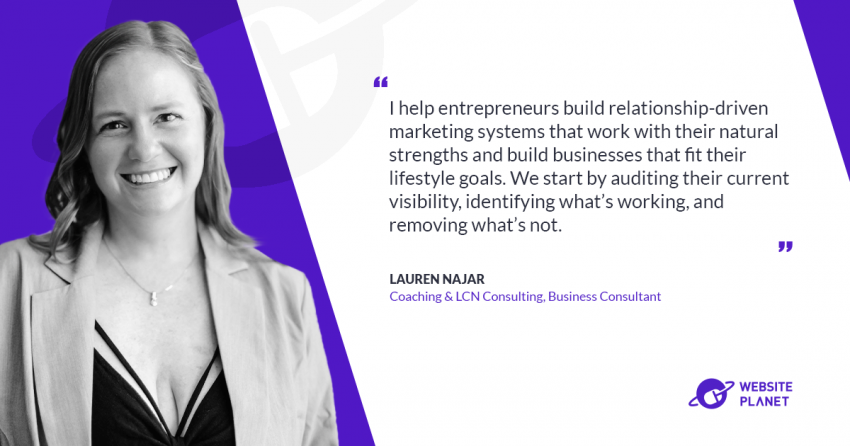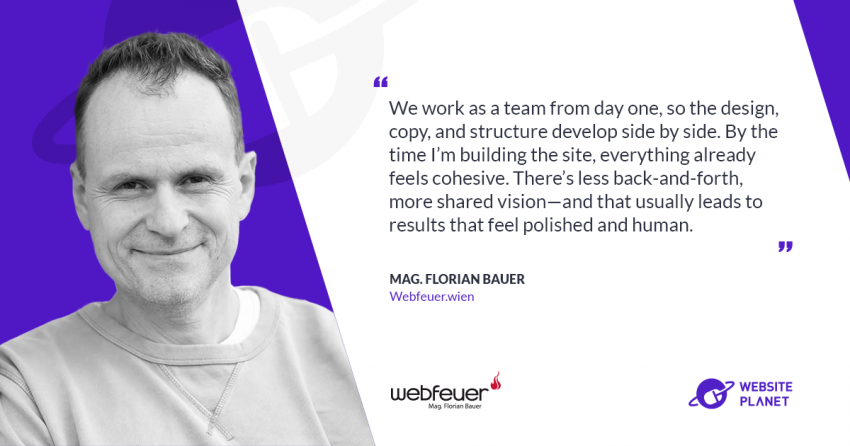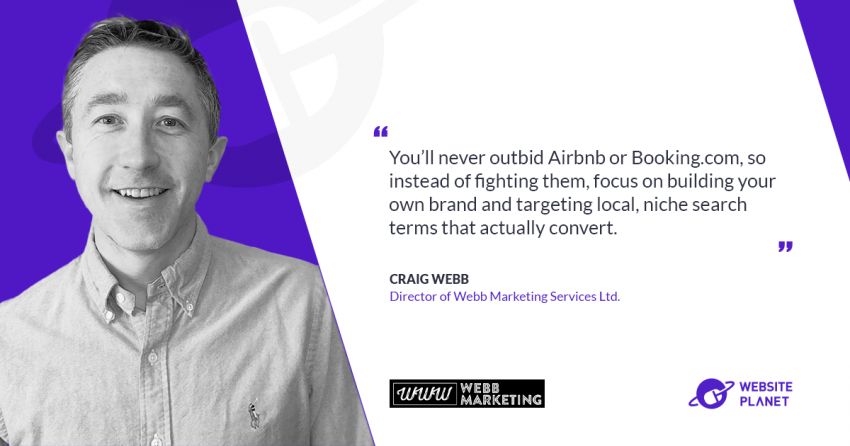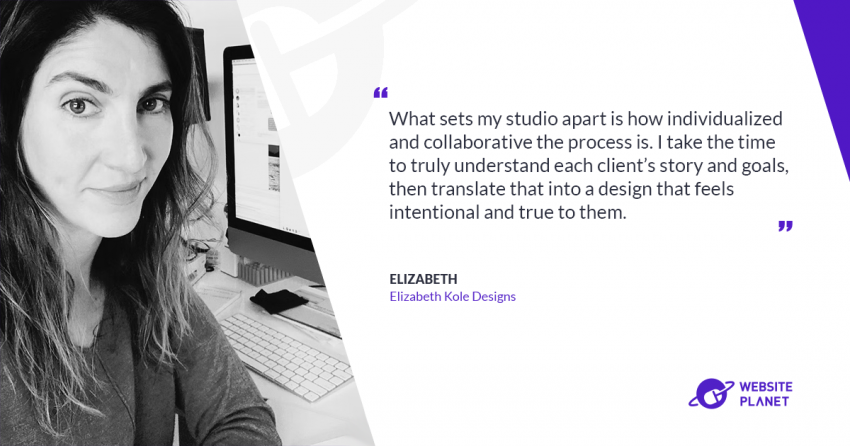Are you considering a career change into user experience (UX) design and want an affordable, expert-led education?
Naveed Ratansi, founder of UX Academy, has been bridging the gap in UX education, offering real teachers and practical skills to aspiring designers.
In this interview with Website Planet, he discusses their user-centered approach, hands-on experience with real clients, and the skills needed to address today’s website owners’ challenges.
Read on to discover how UX Academy better prepares students for the evolving UX design industry, Naveed’s recommended learning resources, and his strategy to adapt to industry shifts.
What sparked the idea of starting your academy, and how has it evolved during the years?
I originally started running monthly meetups around Mobile UX Design, which then turned into a large annual conference with around 250 attendees consisting of workshops and talks. The idea of starting UX Academy was then sparked by a combination of factors that we believed were essential for bridging the gap in UX education. Seeing that many UX design courses were financially out of reach for aspiring designers, we set out to offer a high-end course that was affordable and accessible. While many courses relied on pre-recorded content, we believed in the value of real teachers and industry experts with over 7 years of experience.
Early on, our approach evolved as we recognised the importance of equipping students with practical skills for future employment. This shift involved prioritising hands-on experience, allowing students to work directly with real clients and tangible projects.
By teaching our courses online we have been able to reach international students, provide additional weekly mentorship, and offer post-training support.
UX Academy’s journey began with a commitment to provide affordable, practical, and expert-led education for aspiring UX designers. Over time we worked to make it the most comprehensive learning experience on the market.
Can you highlight the key principles and skills that your courses cover, and how they align with the pain points currently faced by website owners?
Our courses focus on user-centred design (UCD), an approach focused on user’s feedback to validate each step of the design process.
Our courses cover information architecture principles, helping students to create clear and organised website responsive structures, as responsive designs are becoming increasingly important with the use of mobile devices, websites need to adapt seamlessly to different screen sizes.
We also discuss interaction design principles to enable students to create compelling user interfaces to enhance the user experience. This knowledge is put into practice during the real-client project, where students can leverage their knowledge to deliver an optimal outcome.
By aligning our courses with key principles and skills, we ensure our students are well-equipped to address the current challenges faced by website owners. We believe that a user-centred approach to design is the key to creating websites that not only meet user expectation but also drive business success.
How do you help students gain practical experience?
One of the cornerstones of our approach is the inclusion of a real-client project in our courses. Students apply their learning to solve the UX challenges faced by a real company. This practical experience not only prepares them for the demands of the industry, but also builds their portfolio. We guide students in creating their portfolio that best showcases their projects, as a strong portfolio is a key asset when seeking employment within the UX field.
Students also engage in practical exercises during their classes, to put into practice the knowledge they have acquired during the lesson. These exercises take place within the supportive learning community of their peers and instructor, providing them with the opportunity to seek guidance and assistance when necessary. For instance, collaborative work within Figma facilitates real-time teamwork on a single file. Figma is an industry standard UX tool, this hands-on experience with professional tools prepares them for the requirements of their future roles.
What kind of support do you have in place to assist your students?
Our support system is designed to assist the diverse needs of our students throughout the course and beyond. We are committed to providing guidance, resources, and assistance to help each student succeed in their UX design journey.
Our courses are led by experienced instructors who are passionate and provide regular feedback, guidance and assistance to the project, and answer questions during and outside lesson time.
Moreover, all classes are recorded, and the lesson slides are readily available 24/7, ensuring students can review course materials and additional reading as often as needed.
Once a week, a mentor provides assistance to the project, answers any questions and goes over any course material a student may be struggling with, they share their experience and industry insights to help students navigate the challenges they encounter. These regular check-ins ensure students are on track to meet their learning goals and project deadlines.
By working within a team, students can connect with like-minded individuals, creating a supportive and collaborative learning community.
Could you share any success stories of students who have taken your courses and landed a great position or started their own business?
Over the years, we have had the privilege to witness numerous students who, after completing our courses, have gone on to secure remarkable positions within the industry.
For example, Vita, formerly a Marketing Designer who chose to enrich her skill set through our UX/UI Design Course. Today, Vita is thriving in a UX Design role, crafting exceptional digital experiences.
Also, Chrysanthi transitioned from her role as a Customer Service Coordinator & Trainer to a UX Writer after completing our course. These success stories are a testament to the transformative power of our educational courses.
What books, podcasts or other resources do you usually recommend to your students?
For beginners in UX design, we recommend these 4 foundational books:
- User Experience Design by Galvin Allanwood
- Practical UI Patterns for Design Systems by Diana MacDonald
- Good Services by Lou Downe
- The Design of Everyday Things by Donald Norman
For advanced UX designers, we recommend delving into these 5 books to further expand your expertise:
- Business Thinking for Designers by Ryan Rumsey
- Design Thinking Handbook by Eli Woolery
- Don’t Make Me Think by Steve Krug
- Forever Employable by Jeff Gothelf
- Happiness by Design by Paul Dolan
What opportunities and challenges do you see in the future of your industry, and how do you plan to adapt?
We constantly review our curriculum to ensure that students are well-prepared for the future and are up to date with the latest industry trends within the field.
As the demand for UX designers grows, so does the competition. We understand the importance of helping our students stand-out, so our portfolio development support is designed to address this challenge.
Indeed, one of the most important challenges involves bridging the skills gap, so we ensure that all our students graduate with the skills that are in demand and help them succeed for the future.
Our approach is to embrace the opportunities presented by technological advancements and the demand for UX designers whilst addressing the challenges within the industry. This is done through ongoing curriculum updates and preparing students for the competitive landscape of the UX design industry.
